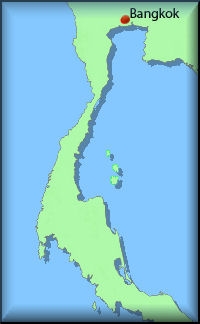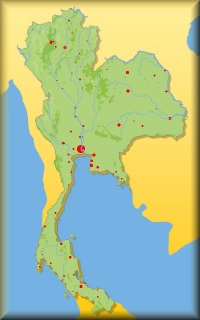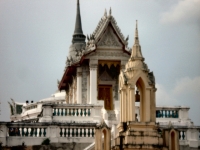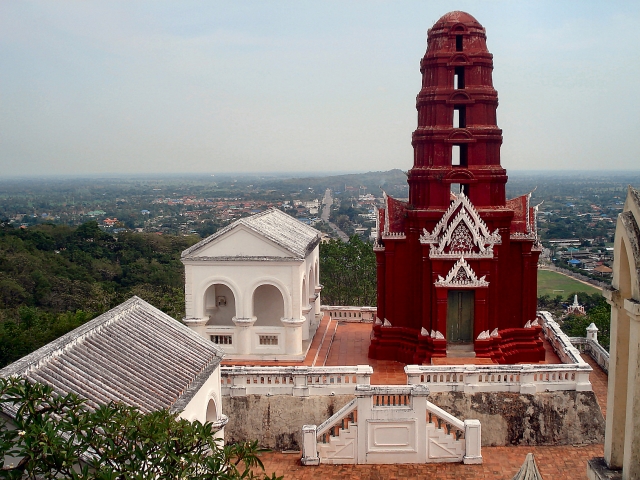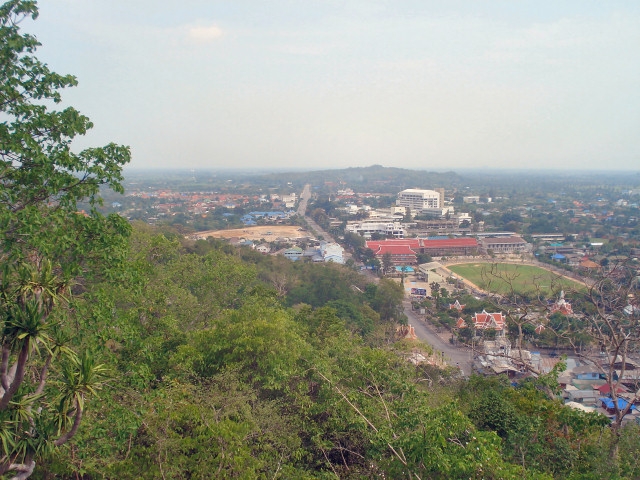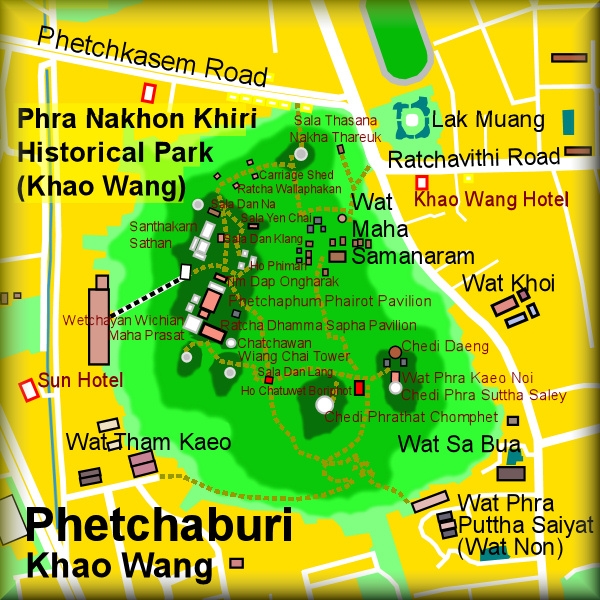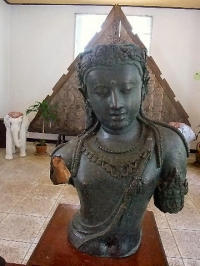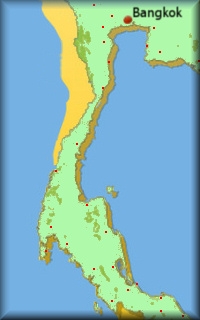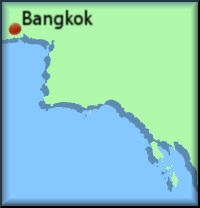 |
Museums in the South
Museum >>
National Museum Chumphon (National Museum, Chumphon) (Chumphon) 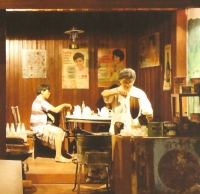 The museum stands on the Hill of Sam Kaeo Mountain, in the area of the government center in Chumphon. The building is designed as an integrated style of local and contemporary themes, specially built for protection against strong winds, and at the same time, be appropriate for use as a museum. The local style of architecture is dominant. The museum stands on the Hill of Sam Kaeo Mountain, in the area of the government center in Chumphon. The building is designed as an integrated style of local and contemporary themes, specially built for protection against strong winds, and at the same time, be appropriate for use as a museum. The local style of architecture is dominant.The dominant feature of the local style of architecture appears in the museum buildings The ancient site of Sam Kaeo Mountain or “Khao Sam Kaeo” is found in a steep limestone gully in the mountain range which runs through Thung Tako, Sawee Pathiw and Pha To districts. Here, many prehistoric artifacts were found and brought for display to the museum. These include potsherds, tripods, flake and polished stone tools. The evidence shows people migrated further down the plain and settled there. Afterwards, these people interacted with other communities by land and sea. As Chumphon’s location was near the seashore, it became an early important port for trade by the 1st century A.D. This had a substantial effect on the way of life here. The place was known as “The Port of Khao Sam Kaeo.” Because it was a major trading port, many archaeological finds were excavated showing that trade flourished in both eastern and western directions, during the first century onwards; some of these artifacts are: bronze human and animal figures, iron tools, bronze drums and beads. Beads are the most important proof of the trading relationship between the community of Khao Sam Kaeo and people from overseas. Beads were made of glass and stone, and some were inscribed in the Pallava script. These beads were used as ordinary ornaments which people from India, Arab and Roman cultures brought with them while traveling here. The importance of this port continued on for four hundred years. In the meantime, many additional ports along the Andaman coastline were opened, such as the Port of Phu Khao Thong of Ranong province and Khuan Luk Pat, Khlong Thom of Krabi. Also, in the Gulf of Siam, new ports opened south of Chumphon, namely, Tha Chana and Chaiya Ports of Surat Thani and Sathing Phra of Songkhla. By the 5th century onwards, the significance of the Khao Sam Kaeo port of Chumphon began to decline. Situated to the north of Chumphon city across the railway track right by the side of bypass road H1007. Situated to the north of Chumphon city across the railway track right by the side of bypass road H1007. 1200 Years of History and Artifacts
Museum
Museum
Museum >>
Songkhla National Museum (พิพิธภัณฑสถานแห่งชาติ สงขลา) (Songkhla) Rates: 10 to 30 Baht 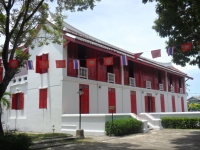 A remarkable characteristic of the museum is its architecture. A mixture of Chinese and Western influences, it was built more than a hundred years ago. The building is constructed of bricks and plaster painted white, while the door and window panels, including the Chinese style roof ornaments, are red. The roof is covered in Terracotta tiles with a perforated ridge. The capitals of columns, crossbeams, and walls under the pediments are decorated with frescoes, bas reliefs of Chinese deities, and floral designs which are signs of good fortune. The building has been restored from time to time and has become a treasure of Songkhla Province for its beauty and historic value. The building was awarded “An Art on Architecture” from the Association of Siamese Architecture in 2007. A remarkable characteristic of the museum is its architecture. A mixture of Chinese and Western influences, it was built more than a hundred years ago. The building is constructed of bricks and plaster painted white, while the door and window panels, including the Chinese style roof ornaments, are red. The roof is covered in Terracotta tiles with a perforated ridge. The capitals of columns, crossbeams, and walls under the pediments are decorated with frescoes, bas reliefs of Chinese deities, and floral designs which are signs of good fortune. The building has been restored from time to time and has become a treasure of Songkhla Province for its beauty and historic value. The building was awarded “An Art on Architecture” from the Association of Siamese Architecture in 2007.Built in 1878 by Phraya Suntharanurak (Net Na Songkhla), a governor of Songkhla during the reign of King Rama V, the building was formerly a residency of the Na Songkhla family. It was given for official use in 1904, for the intendancy of Nakhon Si Thammarat precinct when Phraya Yomarat (Pan Sukhum) was the intendant. (The position of the ruler of Songkhla changed to that of a governor who was under government authority, and who served as the commander-in-chief of the precinct.) Later, during 1933-1953, it was used as a city hall, until the Fine Arts Department declared it a national monument in 1973. The building is constructed in a rectangular shape around a courtyard with a big tree in the middle. There are two stairways leading to the second floor. The space on each floor is divided into rooms and balconies which are used as the exhibition galleries. Exhibitions on the lower floor focus on archaeological evidence and arts found on the peninsula of Thailand. Some of these ancient art objects are considered masterpieces by scientific researchers. Thai, Chinese, Vietnamese, and European ceramics provide important evidence which verifies that Songkhla was once an important trading port. In contrast, the second-floor exhibition is totally centered on the presentation of furniture and daily items used by the well-to-do. Exhibited are a bench-bed, betel nut sets, food trays, niello wares, mirrors, cosmetic sets, beds and chairs, altars, candlesticks, vases, joss stick pots, etc. These objects are a reflection of the Chinese community and its importance in helping the city of Songkhla thrive during the 19th century. In addition, there are cultural objects that illustrate the way of life of the people in the South, such as tools, utensils, musical instruments, and games. They are outstanding examples of the living style of the Thais in the past. The artefacts document the civilizations of the peninsula in the regions of Songkhla, Phatthalung, Satun, Pattani, Yala, and Narathiwat. The exhibition starts off with the prehistory of the region and continues into the historical period. Most of the artefacts are archaeological finds from sites around districts of Songkhla, such as in the ancient town of Sathing Phra and other ancient communities around the Songkhla lagoon. Proof in the form of artefacts attests to the importance of Songkhla Province in particular as a leading community on the peninsula. It is open to the public from 9 to 4 except Monday, Tuesday, and public holidays. Tel: 074-311728.
Museum >>
Phuket Seashell Museum (พิพิธภัณฑ์เปลือกหอย ภูเก็ต) (Phuket) Phuket Seashell Museum showcases a collection of seashells from every part of the world. There are shell fossils that are hundreds of millions of years old, a giant shell weighting more than 250 Kg., a golden pearl that weights 140 karats, etc. Phuket Seashell Museum is open daily form 8.00 am. - 17.00 pm. For more information call 076-613678, 076-613789, 076-316666. Fax : 076-613777. Phuket Seashell Museum is located near Rawai Beach. |
New to t-Globe?
Register for free to get the full power of this web site!
Registered members will be able to: |
||||||||||||||||||||||||||||||||||||||||||||||
|
|

